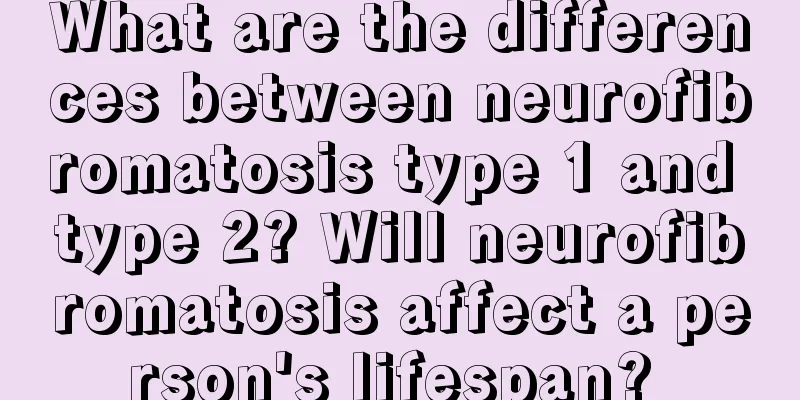What are the differences between neurofibromatosis type 1 and type 2? Will neurofibromatosis affect a person's lifespan?

|
Neurofibromatosis (NF) is a benign tumor that occurs in the leucocarpal and perineurial cells of the axonal sheath of the nerve trunk or peripheral nerves. It is an autosomal dominant hereditary disease. Typical symptoms: Type 1: Café au lait spots: Almost all patients have skin pigmentation spots that are light brown, dark brown or coffee color. Multiple neurofibromas: Patients often complain of painless subcutaneous tumors throughout the body. The most common initial symptom of type 2 is bilateral progressive hearing loss. Neurofibromatosis symptoms diagnosis Most patients are adults, with an equal incidence in men and women. Neurofibromas can have three benign stages: late, active, and invasive; but they can also transform into sarcomas. 1. Clinical classification There are seven clinical types of this disease. Type 1 NF (classic neurofibromatosis): more than 85% of all NF patients. Patients have many neurofibromas ranging in size from a few millimeters to several centimeters, and many widely distributed coffee-style spots, with little or no neurological damage. About 1/4 of children under 6 years old and almost all elderly patients have iris Lisch nodules. Type 2 NF (central or acoustic neuroma): Distinguished from type 1 by the presence of bilateral acoustic neuromas. NF type 3 (mixed) and NF type 4 (variant): Similar to NF type 2, but with a greater number of neurofibromas. The above four types have a higher risk of developing optic nerve glioma, neurilemmoma, and meningioma, and are inherited in an autosomal dominant manner. Type 5 NF (segmental or dermatomal neurofibromatosis): Usually non-hereditary, thought to be caused by postzygotic somatic mutations. Can be bilateral. Type 6 NF (no neurofibromatosis): There are no neurofibromas, only café-au-lait spots. Café-au-lait spots must occur within two generations for diagnosis. Type 7 NF (late-onset neurofibromatosis): Neurofibromatosis occurs in patients after the age of 20, and it is not clear whether it is hereditary. 2. Clinical characteristics The main characteristic lesions are neurofibromas, followed by café-au-lait spots, axillary freckles, giant pigmented hairy nevus (neural nevus), sacral hypertrichosis, gyral cutis and macroglossia. (1) Skin symptoms: ① Café au lait spots: Almost all cases can be seen with skin café au lait spots at birth. Pigmentation is a hallmark lesion of this disease and one of the characteristics of neurofibroma. They vary in size, have irregular edges, and do not protrude from the skin surface. They are prone to occur on non-exposed parts of the trunk. They are light brown or dark brown with uniform pigmentation and irregular circles or ovoids. The number is uncertain and the size ranges from widespread black spots to scattered plaques. Pigment cells may also be contained in the tumor. Café au lait spots with a diameter of 1.5 to 5 cm (the minimum diameter for children is 0.5 cm) are seen in infants aged one year. Six or more skin café au lait spots >5 mm before puberty (>15 mm after puberty) have a high diagnostic value and usually indicate type l NF. Some may be normal skin color or slightly reddish. ② Skin fibroma and fibrous soft tumor: Skin neurofibroma is a dermal tumor that occurs in childhood. It is a single or multiple skin or subcutaneous tumor. It is a round, fusiform or irregular tumor that can be touched on the skin or under the skin. The texture can be tough or soft. The surface of the tumor is smooth or rough, and the size varies. The small one is like a grain of rice, and most of them are the size of sesame, mung bean or citrus. There are pedicles or no pedicles. The large ones weigh several thousand grams and can hang loosely on the body surface in a belt-like shape. It is mainly distributed on the skin of the trunk and face, and also seen on the limbs. It is mostly pink, flesh-colored, and fruit-red. The number is uncertain, and can be as many as thousands. It is soft to the touch like a hernia. The soft tumor is fixed or pedicled, soft and elastic to the touch. The neurofibroma of the superficial cutaneous nerve is like a pearl-like nodule, which is movable and can cause pain, tenderness, radiating pain or paresthesia. Gentle pressure with fingers can push the soft tumor into the fat layer, and it will bounce back when the fingers are released, which can be distinguished from lipoma. A. Molluscum-like hyperplasia: Molluscum-like tumor proliferation on the skin, scattered throughout the body, with varying numbers from a few to thousands. B. Subcutaneous fusiform neuroma C. Plexiform neurofibroma: Rare. It is a diffuse neurofibroma of the nerve trunk and its branches, often accompanied by massive proliferation of the skin and subcutaneous tissue, causing diffuse hypertrophy of the area or limbs, called neurofibromatous elephantiasis. It is a nodule that grows slowly along the peripheral nerves, showing diffuse swelling and unclear boundaries. The tumor can be highly proliferative, wrinkled, swollen and sagging, and it feels like a bag of worms when touched. Plexiform neuromas often appear clearly in a certain nerve distribution area, such as the median nerve in the hand, the fifth and eighth cranial nerves in the face, or the distribution area of the upper cervical nerves. When the eighth cranial nerve is in time, it can cause unilateral or bilateral deafness. If the base of this tumor is found to be tightly fixed to the deep tissue or grows rapidly, or there is severe local pain, the possibility of malignant transformation should be suspected. Some tumors have no capsule and grow outward with unclear surrounding boundaries, which often leads to the sagging, deformation and displacement of local and adjacent organs, causing obvious deformity and functional impairment, which is called elephantiasis neuromatosa. ③Other skin lesions: Freckles on the whole body and in the axilla (Crowe's sign) are also one of the characteristics. Large and dark pigmentation indicates clustered neurofibromas, and those located in the midline indicate spinal cord tumors. Clinically, it can be misdiagnosed as melanin disease. Axillary freckles can extend to the neck, and those occurring in the groin can extend to the perineum. In addition, bronze coloration and excessive pigmentation can be seen on the skin. There are also patients with concomitant yellow granulomas. (2) Nervous system damage: Mental retardation, dementia, epilepsy and various intracranial malignancies may occur. About 50% of patients experience neurological symptoms, mainly caused by compression of central or peripheral nerve tumors, followed by glial cell proliferation, vascular proliferation and bone deformities. ① Intracranial tumors: Acoustic neuroma is the most common, and bilateral acoustic neuroma is the main feature of NFⅡ. It is often combined with meningioma, multiple meningiomas, gliomas, ventricular ependymomas, meningocele and hydrocephalus, spinal nerve posterior root schwannoma, etc. The optic nerve, trigeminal nerve and posterior cranial nerves can all occur. In a few cases, there may be mental retardation, memory impairment and epileptic seizures. ② Intraspinal tumors: Single or multiple neurofibromas and meningiomas may occur at any plane of the spinal cord, and may be accompanied by spinal deformity, myelocele and syringomyelia. ③ Peripheral nerve tumors: All peripheral nerves can be affected, especially the cauda equina. The tumors are distributed along the nerve trunks in a beaded manner. Generally, there are no obvious symptoms. If they suddenly grow larger or cause severe pain, they may be malignant. (3) Eye symptoms Iris Lisch nodules are seen in almost all adult patients. Fibromas or plexiform neurofibromas can be seen on the upper eyelid, masses and exophthalmos can be palpated in the eye sockets, and slit lamps can reveal miliary orange-yellow round nodules on the iris, which are hamartomas, also known as Lisch nodules. They may increase with age and are a unique manifestation of NFⅠ. Gray-white tumors can be seen in the fundus, with convex optic discs; optic nerve gliomas can cause exophthalmos and vision loss. (4) Bone damage: Adjacent bones may compress the bones to produce pressure marks, which are usually erosive and can cause bone deformities. Common congenital bone developmental abnormalities include scoliosis, kyphosis and protrusion, skull asymmetry, defects and depressions, congenital tibiofibular pseudoarthrosis, spina bifida, dislocation and non-traumatic fractures, causing excessive limb hypertrophy, etc. Direct compression of tumors can lead to bone changes, such as acoustic neuroma causing enlargement of the internal auditory canal, spinal neuroma causing enlargement of the intervertebral foramen and bone destruction; overgrowth of long bones, facial bones and sternum, long bone hyperplasia, diaphysis bending and pseudoarthrosis formation are also common; tumors can occur in the adrenal glands, heart, lungs, digestive tract and mediastinum. Isolated deep neurofibromas grow slowly and are discovered due to asymmetry or compression of nerves. Growth in the proximal fibula can compress the common peroneal nerve and cause foot drop, which is rarely painful, but it is not uncommon for them to turn into fibrosarcomas. (5) Others: ① Endocrine damage: acromegaly, cretinism, myxedema, hyperthyroidism, pheochromocytoma, precocious puberty, etc. ② Lung damage: Diffuse interstitial pneumonia may occur in a small number of patients. ③ Malignant tumors: Cutaneous neurofibromas may occasionally develop into neurofibrosarcomas and malignant neurilemmomas. There are also reports of cases with Wilm's tumors, rhabdomyosarcomas, and chronic myeloid leukemia. 3. TCM Syndrome Differentiation Traditional Chinese medicine believes that this disease is mostly caused by congenital defects, or damage to the lung qi, loose pores, invasion of external evil, disharmony of qi and blood, and blockage of meridians, resulting in skin disease. The diagnosis is based on medical history, clinical manifestations, X-ray examination, radionuclide scanning and arterial angiography. The final diagnosis is based on pathology. 1) Qualitative diagnosis (1) Medical history and family history: This disease is inherited irregularly and is autosomal dominant. Careful questioning can reveal family members with the disease. (2) Clinical features: Verrucous hyperplasia, subcutaneous spindle-shaped neuromas, plexiform neuromas, and pigmentation are the four main features of this disease. (3) Laboratory examination: Autosomal abnormalities can be confirmed by tissue pathology. 2) Typing diagnosis (1) Type 1 NF: Diagnosed if two or more of the following criteria are met: ①6 or more café-au-lait spots, the size of which is: the maximum diameter is 5cm before puberty and the maximum diameter is 15cm in adults. ②2 or more neurofibromas of any type or 1 plexiform neurofibroma. ③ Freckles in the armpits and groin. ④Optic nerve glioma. ⑤2 or more Lisch nodules. ⑥ Obvious bone damage such as abnormal development of the sphenoid part and thinning of the long bone cortex with or without pseudoarthrosis. ⑦ First-degree relatives (parents, siblings, children) suffer from the disease. (2) Type 2 NF: Diagnosis requires any one of the following criteria. ①CT or MRI: confirmed the presence of bilateral acoustic nerve tumors. ② One of the first-degree relatives has type 2 neurofibroma or a lower tumor, such as unilateral acoustic neuroma or two of the following tumors (neurofibroma, meningioma, glioma, schwannoma, or juvenile posterior capsule opacity). 3) Traditional Chinese Medicine It is believed that this disease is mostly caused by congenital defects, or damage to the lung qi, loose pores, invasion of external evil, disharmony of qi and blood, and blockage of meridians, resulting in skin disease. 1. Causes of disease NF is a gene defect that causes abnormal development of neural crest cells, leading to multi-system damage. It can be classified as a neurocutaneous syndrome. According to clinical manifestations and gene location, it is divided into neurofibromatosis type I (NFⅠ) and type II (NFⅡ). The main characteristics of NFⅠ are skin café-au-lait spots and multiple neurofibromas of peripheral nerves. It has a high penetrance and the gene is located on chromosome 17q11.2. NFⅡ is also known as central neurofibroma or bilateral acoustic neuromatosis, and the gene is located on chromosome 22q. This disease is an autosomal dominant genetic disease, and about half of the children of patients may develop the disease. The occurrence of NF may be due to gene mutation, which causes the loss of the function of the gene with growth regulation, so that the cell loses control and proliferates into a tumor. It is a benign tumor mainly composed of fibroblasts that grows in the nerve trunk. The NFⅠ genome spans 350Kb, the cDNA is 11Kb long, contains 59 exons, encodes 2818 amino acids, and constitutes 327kD neurofibromin (neutofibronin), which is distributed in neurons. Except for type 5 NF, which may be a post-zygotic somatic mutation, about 50% of cases represent new gene mutations. NFⅠ gene is a tumor suppressor gene. When translocation, deletion, rearrangement or point mutation occurs, the tumor suppressor function is lost and the disease is caused. The gene of type 1 NF is located in the pericentric region of chromosome 17q11.2. The neurofibromin encoded by this gene is a protein converted from ras protein and has growth regulatory function. The gene of type 2 NF is located on the long arm of chromosome 22q11-q13. The schwannomin encoded by its gene is a glycoprotein that connects the aclincytoskeleton to the cell surface and also plays a role in growth regulation. NFⅡ gene deletion mutation causes Schwann cell tumor and meningioma. 2. Pathogenesis The pathogenesis of this disease is unclear, but it may be due to abnormal development of the neural crest. Recently, it is believed that it is related to excessive production or high activity of nerve growth factor, which promotes abnormal proliferation of nerve fibers and leads to tumor growth. The main pathological characteristics are ectodermal neural tissue dysplasia, excessive proliferation and tumor formation. NFⅠ neurofibroma is prone to occur in the distal peripheral nerves, spinal nerve roots, especially the cauda equina; cranial nerves are more common in the auditory nerve, optic nerve and trigeminal nerve. Intraspinal tumors include ependymomas and astrocytomas. The most common intracranial tumors are brain gliomas. The tumors vary in size, with spindle cells arranged and cell nuclei like fences. 1. General observation Neurofibromas are not always connected to large nerve trunks, but may also arise from very small unmyelinated fibers. There is a loose, translucent, thin capsule with no or slight reaction areas outside. In aggressive fibromatosis, it can infiltrate the surrounding normal tissues, and blunt dissection is difficult to reach the outer edge of the capsule for mass removal. If the tumor is connected to the main nerve trunk, it often invades the nerve tissue. When it is separated outside the capsule, nerve fibers can be seen entering and passing through the tumor. Unlike neurofibromas, it does not invade nerve fibers and damage nerves. It is difficult to remove the entire tumor. Large tumors are mostly stage III lesions, and it is also common for the tumor to degenerate into a cystic cavity containing yellow fluid. Neurofibromas have no capsule, but the boundaries are clear. Located in the dermis and subcutaneous tissue, the tumor is mainly composed of nerve membrane cells and nerve sheath cells, and many proliferating nerve axons and abundant small blood vessels can be seen. The fibrous tissue is thinner, tightly arranged, and slightly curled to form a wavy shape. Sometimes, myxoid degeneration of fibers can be seen. In milk coffee spots, the melanin in the basal cell layer of the epidermis increases, and huge pigment granules can be seen. 2. Microscopic morphology Electron microscopic examination shows that these tumors are formed by the proliferation of fibroblasts or peripheral nerve membrane cells. The main manifestation is that loose spindle cells produce fine fibrous eosinophilic matrix, which is undulating and regular, with phagocytes, lipids and hemosiderin; there are also Verocay bodies, vascular proliferation, mature fat, mature fibrous nodules, etc., which are called mixed neurofibromas. NFⅡ is more common in bilateral acoustic neuromas and multiple meningiomas. The tumor cells are loosely arranged, and megakaryocytes are common. Two types of pathological changes were found in histopathological examination. (1) Cutaneous neurofibroma: It has no capsule and is composed of neuropil cells and neurosheath cells. Neuropil cells are immature collagen fiber bundles with thin fibrils in the bundles and some fibers have mucus between them. Neuropil cells are slender rhombus or slightly curved and wavy, with unclear cell boundaries, pale eosinophilic cytoplasm, and obvious filamentous processes of different lengths at both ends; the nucleus is often darkly stained, and most of them are loosely arranged parallel to the collagen fiber bundles in a wavy or swirl pattern. (2) Subcutaneous plexiform neurofibroma: It invades the surrounding large nerves and irregular nerve bundles are seen. The proliferating nerve sheath cells and collagen fibers form curved cords surrounded by a myxoid amorphous stroma. Immunohistochemically, neurofibromas have different antigen expressions depending on their main cell types. S-100 protein and type 4 collagen are positive for nerve sheath cells, epidermal membrane antigen is positive for nerve sheath cells, vimentin is positive for fibroblasts and nerve sheath cells, and neurofilaments and myelin basic protein are positive for axons and myelin sheaths. In addition, the disease may also have lesions such as meningocele, syringomyelia, and congenital malformations. Some patients also have lesions outside the nervous system, such as metabolic bone disease causing bone hyperplasia, cranial foramen occlusion, bone sparseness and cyst formation due to the replacement of normal bone by fibroblasts and fibrocytes; congenital spinal anomalies, bone cysts, tibial pseudoarthrosis; hypertrophy of a limb and hemi-tongue or face, scoliosis, etc. There are also reports of abnormal cerebral cortical histology, ectopic islands of gray matter, and localized gliosis, which may be the cause of mental retardation. Tumors are usually benign and grow slowly. About 3% to 4% may become malignant, especially large plexiform neuromas. Malignant transformation is mostly peripheral tumors, and central tumors rarely become malignant. Skin fibroma and fibroma are formed by the proliferation of fibrous tissue. They are mostly located in the dermis or subcutaneous tissue, without cell membranes, and the skin pigmentation is caused by the deposition of melanin in the basal cell layer of the epidermis. 1. Neurofibromatosis is an autosomal dominant disease, and children have a 50% chance of developing the disease, so sterilization should be considered. 2. People with a family history of genetic diseases should pay attention to self-monitoring. If a tumor is found to grow rapidly in a short period of time, it may become malignant. Go to a qualified hospital for diagnosis and treatment in time. 3. If serious complications occur, such as intracranial tumors, gastrointestinal involvement causing bleeding and intestinal obstruction, or huge retroperitoneal neurofibromas causing heavy pressure on internal organs, and surgery is required, you must cooperate with the doctor. 4. Conduct genetic counseling. Preventive measures include avoiding marriage between close relatives, gene detection for carriers, prenatal diagnosis, and selective artificial abortion to prevent the birth of affected children. 1. Treatment There is no specific treatment. Surgical resection is the only effective treatment for this disease. Some patients can use radiotherapy, and epileptic seizures can be treated with anti-epileptic drugs. Other measures are mainly symptomatic treatment. 1. Surgical resection is the only treatment method. The purpose of surgical resection is to relieve symptoms and reduce the size of the tumor. Acoustic neuroma, optic neuroma and other intracranial and intraspinal tumors can be treated surgically. It is not as easy to remove the entire block of the capsule as a schwannoma because its capsule is unclear and it is easy to relapse. The recurrence rate is lower if the outer edge of the capsule is removed, and wide resection is a definite treatment with a very low recurrence rate. For those who do not grow on a large nerve trunk, wide or marginal resection can be performed. For those who grow on a large nerve trunk, such resection will damage the nerve and cause disability. In this case, intracapsular resection is still performed, although recurrence may occur and involve the nerves, and it is very difficult to perform intracapsular resection again. Radiotherapy is generally not performed because it can damage the nerves. Small and localized tumors should be completely removed at one time. Large, extensive or multiple tumors are usually difficult to completely remove and cannot be cured. Staged resection can be considered. First, selective resection should be performed on areas that damage the appearance, hinder function, or are suspected of malignant transformation. The amount of resection should be estimated during staged resection. If too much is removed and the wound edges are too tight after suturing, complications such as wound edge necrosis and wound dehiscence may occur. Most tumor resections can cause soft tissue defects, which should be repaired by combining the application of microsurgical techniques with large muscle flap transplantation. 2. Skin flap transplantation is pedicled skin flap transplantation, which requires the skin flap to have 1 to 2 blood vessels (including arteries and veins) as pedicles to ensure the survival of the skin flap. Skin flap transplantation is divided into two categories: flat skin flap transplantation and tubular skin flap (skin tube) transplantation. The latter is mainly used in plastic surgery and will not be introduced here. (1) Production of flat flaps: Flat flaps are also called simple flaps or open flaps. This type of flap is transplanted in a flat form and usually requires only one pedicle, but sometimes two pedicles are required. The length-to-width ratio of the flap is generally no more than 1.5:1, but in the head and face where blood supply is relatively rich, the length-to-width ratio can reach 3-4:1. In the lower leg area where blood supply is relatively poor, the length-to-width ratio can only be 1:1, otherwise blood supply obstruction may occur, affecting the survival of the flap. The size of the flap can be designed according to the direction of the blood vessels. The pedicle should point to the proximal end of the blood vessels. The wound surface of the donor area can be directly sutured or repaired with a medium-thickness skin graft. (2) Skin flap transplantation: ① Local rotation method: It is to use part of the normal skin tissue around the defect to make a flap, rotate the flap locally at a certain angle and transfer it to the defect to repair the wound. The design of the rotation flap requires that the long diameter is larger than the long diameter of the wound to avoid too tight transplantation. Excessive tension after suturing will cause the incision to split, and at the same time affect the blood supply of the flap. After the flap is rotated, wrinkles of varying severity often appear on the pedicle near the defect side due to different rotation angles. The larger the angle, the more obvious it is. However, this wrinkle cannot be removed immediately, otherwise it will cause blood supply obstruction and necrosis due to the narrowing of the pedicle. Some donor areas after flap transplantation can be sutured directly, while others need to be repaired by transplanting skin grafts. ② Local advancement method: Using the extensibility of the skin, a skin flap is formed on the skin around the wound, and the skin flap is pushed vertically toward the wound to repair the wound. The wound in the donor area can be slightly separated by the two sides of the "V"-shaped incision and then pulled together to make a "Y"-shaped suture. The wound can also be repaired by a "Y"-shaped incision and a "V"-shaped suture. ③ Local lateral shift method: Make a tension-relieving incision at an appropriate distance outside the wider wound that cannot be sutured directly, and make subcutaneous separation from the incision to the wound to form a double-pedicled flat skin flap, which is then shifted to repair the wound. It is often used to repair longitudinal spindle-shaped skin defects in the anterior tibial area of the lower leg and wounds with exposed bone tissue. The ratio between the length and width of the flap is generally 1.5:1, and the donor area wound is transplanted with a medium-thickness skin graft for repair. ④ Distal transfer method: The donor area of the flap is located at a distant part of the defect area, such as the wound on the anterior tibial area of the calf, which can be repaired with the contralateral calf flap. The wound on the finger can be repaired with the contralateral chest wall flap. 3. Notes (1) Patients with neurofibroma sometimes have poor tolerance to surgery and should be paid attention to. (2) Huge tumors on the limbs may often rupture, leading to infection and suppuration, which may eventually lead to amputation. (3) After flap transplantation, the flap should be properly bandaged and fixed to minimize deformation and movement of the tissue in the recipient area to ensure that the transplanted flap is closely attached to the wound surface. 4. Treatment by Traditional Chinese Medicine Principles of Traditional Chinese Medicine: The method should be to neutralize Qi and blood, promote blood circulation and activate collaterals, soften and eliminate hard masses. Prescription: Salvia miltiorrhiza 15g, Millettia reticulata 30g, Paeonia lactiflora 15g, Safflower 15g, Magnolia officinalis 10g, Citrus aurantium 10g, Sinapis alba 10g, Citrus reticulata peel 10g, Luffa melongena 10g, Bombyx batryticatus 10g, Fritillaria thunbergii 10g. (II) Prognosis The prognosis is good, and malignant transformation is rare. Patients with concomitant intracranial meningioma and glioma, peripheral nerve sarcoma and other malignant tumors have a poor prognosis. This disease generally develops slowly, but it can accelerate during adolescence or pregnancy, and the incidence of malignant transformation is about 7%. Patients with concomitant intracranial meningioma and glioma, peripheral nerve sarcoma and other malignant tumors have a poor prognosis. Pickled vegetables: Rich in cellulose, they can promote gastrointestinal emptying and reduce the stimulation of toxic substances in the intestines on neurofibromas. 100g of pickled vegetables can be fried with eggs for consumption. Egg custard: It is rich in protein, soft in texture, easy to digest and absorb, and is helpful in alleviating the clinical symptoms of skin nodular changes caused by this disease. 3 eggs can be prepared into a lotus egg for consumption. Houttuynia cordata: It has the function of increasing tissue immunity, promoting the dissipation of inflammation in the body, and is beneficial to the treatment of this disease combined with bacterial infectious diseases. 100g can be eaten cold. Pepper: It is a spicy food that can stimulate nerve infection and cause peripheral nerve inflammation. So try to eat cold or mild food. It is advisable to eat tomatoes and radishes. Garlic sprouts: They are warm foods, and have the same properties as garlic. They are not good for people with infectious diseases. If necessary, they can be fried and eaten in small amounts. Pickles: Rich in nitrite, they increase the incidence of digestive tumors and have an adverse inhibitory effect on the body's immune function. |
Recommend
What material is good for a bath tub
Many people have the habit of taking a bath. The ...
How to use eye shadow stick
Eye shadow is a very important item in makeup. Ap...
Why does my mouth hurt after radiotherapy for nasopharyngeal carcinoma
Why does my mouth hurt after radiotherapy for nas...
Phlegm and bad breath, little trick to solve it
Some people have phlegm and bad breath, which wil...
What are the symptoms of endometrial cancer?
What are the symptoms of endometrial cancer? 1. P...
What is hepatobiliary cell carcinoma? Common malignant tumors
There are many places where various cancers are f...
Dietary taboos for breast cancer patients: Try to avoid eating high-fat foods
Breast cancer patients should try to avoid eating...
Why do I sweat while drinking water and eating?
For people with poor physical fitness, due to the...
What are the main daily medications for teratoma patients
Teratoma is a common disease in women. It is a be...
Is Mycosporic Folliculitis Easy to Treat?
Many people think that folliculitis is a skin dis...
How is prostate cancer diagnosed? What are the symptoms of prostate cancer progression?
Nowadays, people are afraid of cancer, but in fac...
How to do your hair in a simple and beautiful way
In our daily life, many people like to tie their ...
How to make homemade dishwashing liquid from grapefruit peel?
Pomelo peel refers to the peel peeled from the po...
Harmful gases and dust are the main causes of laryngeal cancer
The causes of laryngeal cancer may be related to ...
What is the matter with low total cholesterol
It is possible for total cholesterol to be high o...









